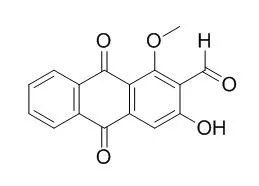| Kinase Assay: |
| Oncol Lett. 2014 May;7(5):1479-1484. | | Damnacanthal is a potent inducer of apoptosis with anticancer activity by stimulating p53 and p21 genes in MCF-7 breast cancer cells.[Pubmed: 24765160] | Damnacanthal, an anthraquinone compound, is isolated from the roots of Morinda citrifolia L. (noni), which has been used for traditional therapy in several chronic diseases, including cancer. Although noni has long been consumed in Asian and Polynesian countries, the molecular mechanisms by which it exerts several benefits are starting to emerge.
METHODS AND RESULTS:
In the present study, the effect of Damnacanthal on MCF-7 cell growth regulation was investigated. Treatment of MCF-7 cells with Damnacanthal for 72 h indicated an antiproliferative activity. The MTT method confirmed that Damnacanthal inhibited the growth of MCF-7 cells at the concentration of 8.2 μg/ml for 72 h. In addition, the drug was found to induce cell cycle arrest at the G1 checkpoint in MCF-7 cells by cell cycle analysis. Damnacanthal induced apoptosis, determined by Annexin V-fluorescein isothiocyanate/propidium iodide (PI) dual-labeling, acridine-orange/PI dyeing and caspase-7 expression. Furthermore, Damnacanthal-mediated apoptosis involves the sustained activation of p21, leading to the transcription of p53 and the Bax gene.
CONCLUSIONS:
Overall, the present study provided significant evidence demonstrating that p53-mediated Damnacanthal induced apoptosis through the activation of p21 and caspase-7. | | Mol Biol Cell. 2014 Mar;25(6):828-40. | | Damnacanthal, an effective inhibitor of LIM-kinase, inhibits cell migration and invasion.[Pubmed: 24478456] | LIM-kinases (LIMKs) play crucial roles in various cell activities, including migration, division, and morphogenesis, by phosphorylating and inactivating cofilin.
METHODS AND RESULTS:
Using a bimolecular fluorescence complementation assay to detect the actin-cofilin interaction, we screened LIMK1 inhibitors and identified two effective inhibitors, Damnacanthal (Dam) and MO-26 (a pyrazolopyrimidine derivative). These compounds have already been shown to inhibit Lck, a Src family tyrosine kinase. However, in vitro kinase assays revealed that Dam inhibited LIMK1 more effectively than Lck. Dam suppressed LIMK1-induced cofilin phosphorylation and deceleration of actin retrograde flow in lamellipodia in N1E-115 cells. Dam impaired CXCL12-induced chemotactic migration of Jurkat T lymphocytes and Jurkat-derived, Lck-deficient JCaM1.6 cells and also inhibited serum-induced migration and invasion of MDA-MB-231 breast carcinoma cells.
CONCLUSIONS:
These results suggest that Dam has the potential to suppress cell migration and invasion primarily through the inhibition of LIMK kinase activity. Topical application of Dam also suppressed hapten-induced migration of epidermal Langerhans cells in mouse ears. Dam provides a useful tool for investigating cellular and physiological functions of LIMKs and holds promise for the development of agents against LIMK-related diseases. The bimolecular fluorescence complementation assay system used in this study will provide a useful method to screen for inhibitors of various protein kinases. | | Eur J Pharmacol. 2011 Jan 10;650(1):120-9. | | Activation of p38 MAPK by damnacanthal mediates apoptosis in SKHep 1 cells through the DR5/TRAIL and TNFR1/TNF-α and p53 pathways.[Pubmed: 20951126 ] | The effect of the natural compound Damnacanthal from Morinda citrifolia on SKHep 1 cell growth regulation was investigated.
METHODS AND RESULTS:
Treatment of SKHep 1 cells with Damnacanthal for 24h indicated a dose-dependent antiproliferative activity. Damnacanthal seems to be selective for tumor cell lines, since there is only minimal toxicity against normal hepatocyte cells (FL83B). This is first demonstration that Damnacanthal-mediated apoptosis involves the sustained activation of the p38 MAPK pathway, leading to the transcription of the death receptor family genes encoding DR5/TRAIL and TNF-R1/TNF-α genes as well as the p53-regulated Bax gene. The Damnacanthal-mediated expression of DR5/TRAIL and TNF-R1/TNF-α results in caspase 8 activation, leading to Bid cleavage. In turn, activated Bid, acting with p53-regulated Bax, leads to cytochrome c released from mitochondria into the cytoplasm. Combined activation of the death receptors and mitochondrial pathways results in activation of the downstream effecter caspase 3, leading to cleavage of PARP. TRAIL- and TNF-α-mediated Damnacanthal-induced apoptosis could be suppressed by treatment with caspase inhibitors as well as soluble death receptors Fc:DR5 and Fc:TNF-R1 chimera.
CONCLUSIONS:
Taken together, this study provided first evidence demonstrating that TRAIL-, TNF-α-, and p53-mediated Damnacanthal-induced apoptosis require the activation of p38 MAPK and mitochondrion-mediated caspase-dependent pathways. |
|






 Cell. 2018 Jan 11;172(1-2):249-261.e12. doi: 10.1016/j.cell.2017.12.019.IF=36.216(2019)
Cell. 2018 Jan 11;172(1-2):249-261.e12. doi: 10.1016/j.cell.2017.12.019.IF=36.216(2019) Cell Metab. 2020 Mar 3;31(3):534-548.e5. doi: 10.1016/j.cmet.2020.01.002.IF=22.415(2019)
Cell Metab. 2020 Mar 3;31(3):534-548.e5. doi: 10.1016/j.cmet.2020.01.002.IF=22.415(2019) Mol Cell. 2017 Nov 16;68(4):673-685.e6. doi: 10.1016/j.molcel.2017.10.022.IF=14.548(2019)
Mol Cell. 2017 Nov 16;68(4):673-685.e6. doi: 10.1016/j.molcel.2017.10.022.IF=14.548(2019)